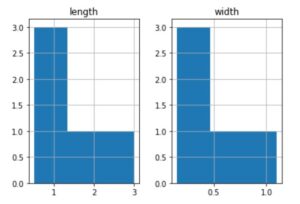Pandas DataFrame Histogram Plot.
Table Of Contents:
- Syntax ‘plot.hist( )’ Method In Pandas.
- Examples ‘plot.hist( )’ Method.
(1) Syntax:
DataFrame.hist(column=None, by=None, grid=True, xlabelsize=None, xrot=None, ylabelsize=None,
yrot=None, ax=None, sharex=False, sharey=False, figsize=None, layout=None,
bins=10, backend=None, legend=False, **kwargs)Description:
Make a histogram of the DataFrame’s columns.
A histogram is a representation of the distribution of data. This function calls
matplotlib.pyplot.hist(), on each series in the DataFrame, resulting in one histogram per column.
Parameters:
- data: DataFrame – The pandas object holding the data.
column: str or sequence, optional – If passed, will be used to limit data to a subset of columns.
by: object, optional – If passed, then used to form histograms for separate groups.
grid: bool, default True – Whether to show axis grid lines.
xlabelsize: int, default None – If specified changes the x-axis label size.
xrot: float, default None – Rotation of x axis labels. For example, a value of 90 displays the x labels rotated 90 degrees clockwise.
ylabelsize: int, default None – If specified changes the y-axis label size.
yrot: float, default None – Rotation of y axis labels. For example, a value of 90 displays the y labels rotated 90 degrees clockwise.
ax: Matplotlib axes object, default None – The axes to plot the histogram on.
sharex: bool, default True if ax is None else False – In case subplots=True, share x axis and set some x axis labels to invisible; defaults to True if ax is None otherwise False if an ax is passed in. Note that passing in both an ax and sharex=True will alter all x axis labels for all subplots in a figure.
sharey: bool, default False – In case subplots=True, share y axis and set some y axis labels to invisible.
figsize: tuple, optional – The size in inches of the figure to create. Uses the value in matplotlib.rcParams by default.
layout: tuple, optional – Tuple of (rows, columns) for the layout of the histograms.
bins: int or sequence, default 10 – Number of histogram bins to be used. If an integer is given, bins + 1 bin edges are calculated and returned. If bins is a sequence, gives bin edges, including left edge of first bin and right edge of last bin. In this case, bins is returned unmodified.
backend: str, default None – Backend to use instead of the backend specified in the option
plotting.backend. For instance, ‘matplotlib’. Alternatively, to specify theplotting.backendfor the whole session, setpd.options.plotting.backend.New in version 1.0.0.legend: bool, default False – Whether to show the legend.
- **kwargs – All other plotting keyword arguments to be passed to
matplotlib.pyplot.hist().
Returns:
- matplotlib.AxesSubplot or numpy.ndarray of them
(2) Examples Of plot.hist() Method:
Example-1:
df = pd.DataFrame({
'length': [1.5, 0.5, 1.2, 0.9, 3],
'width': [0.7, 0.2, 0.15, 0.2, 1.1]
}, index=['pig', 'rabbit', 'duck', 'chicken', 'horse'])
dfOutput:

hist = df.hist(bins=3)Output:


